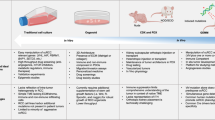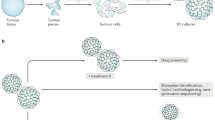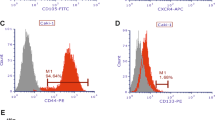Abstract
Traditionally, xenograft models have been used to study tumors in vivo. However, their utility is reduced by the use of tumor cell lines for implantation. Tumorgrafts (TGs; also known as patient-derived xenografts (PDXs)), which involve patient-derived tumor samples, are increasingly recognized as more representative models than traditional xenografts. Furthermore, we showed previously that renal cell carcinoma (RCC) TGs retain the histology, gene expression, DNA copy number alterations, mutations and treatment responsiveness of patient tumors. In skilled hands, implantations require ≤5 min per mouse, and TGs typically grow to 1 cm in 1–4 months. Here we outline the process of implantation of patient-derived RCC samples into the kidneys of immunodeficient mice, as well as the s.c. implantation for preclinical drug testing, including guidelines for the design and execution of drug trials. TGs have extensive applications besides therapeutic studies and may identify biomarkers and mechanisms of resistance. In addition, they may provide insights into tumor biology.
This is a preview of subscription content, access via your institution
Access options
Subscribe to this journal
Receive 12 print issues and online access
$259.00 per year
only $21.58 per issue
Buy this article
- Purchase on Springer Link
- Instant access to full article PDF
Prices may be subject to local taxes which are calculated during checkout







Similar content being viewed by others
References
Siegel, R., Naishadham, D. & Jemal, A. Cancer statistics, 2013. CA Cancer J. Clin. 63, 11–30 (2013).
Janowitz, T., Welsh, S.J., Zaki, K., Mulders, P. & Eisen, T. Adjuvant therapy in renal cell carcinoma-past, present, and future. Semin. Oncol. 40, 482–491 (2013).
Ocana, A., Pandiella, A., Siu, L.L. & Tannock, I.F. Preclinical development of molecular-targeted agents for cancer. Nat. Rev. Clin. Oncol. 8, 200–209 (2011).
Nogawa, M. et al. Monitoring luciferase-labeled cancer cell growth and metastasis in different in vivo models. Cancer Lett. 217, 243–253 (2005).
Liu, J. et al. Metformin inhibits renal cell carcinoma in vitro and in vivo xenograft. Urol. Oncol. 31, 264–270 (2013).
Ebos, J.M. et al. Accelerated metastasis after short-term treatment with a potent inhibitor of tumor angiogenesis. Cancer Cell 15, 232–239 (2009).
Rubio-Viqueira, B. & Hidalgo, M. Direct in vivo xenograft tumor model for predicting chemotherapeutic drug response in cancer patients. Clin. Pharmacol. Ther. 85, 217–221 (2009).
Beroukhim, R. et al. Patterns of gene expression and copy-number alterations in von Hippel-Lindau disease–associated and sporadic clear cell carcinoma of the kidney. Cancer Res. 69, 4674–4681 (2009).
Karam, J.A. et al. Development and characterization of clinically relevant tumor models from patients with renal cell carcinoma. Eur. Urol. 59, 619–628 (2011).
Morton, C.L. & Houghton, P.J. Establishment of human tumor xenografts in immunodeficient mice. Nat. Protoc. 2, 247–250 (2007).
Grisanzio, C. et al. Orthotopic xenografts of RCC retain histological, immunophenotypic and genetic features of tumours in patients. J. Pathol. 225, 212–221 (2011).
Lawrence, M.G. et al. A preclinical xenograft model of prostate cancer using human tumors. Nat. Protoc. 8, 836–848 (2013).
Kim, M.P. et al. Generation of orthotopic and heterotopic human pancreatic cancer xenografts in immunodeficient mice. Nat. Protoc. 4, 1670–1680 (2009).
Chen, K., Ahmed, S., Adeyi, O., Dick, J.E. & Ghanekar, A. Human solid tumor xenografts in immunodeficient mice are vulnerable to lymphomagenesis associated with Epstein-Barr virus. PLoS ONE 7, e39294 (2012).
Garber, K. From human to mouse and back: 'tumorgraft' models surge in popularity. J. Natl. Cancer Inst. 101, 6–8 (2009).
Monsma, D.J. et al. Genomic characterization of explant tumorgraft models derived from fresh patient tumor tissue. J. Transl. Med. 10, 125 (2012).
Fu, X.Y., Besterman, J.M., Monosov, A. & Hoffman, R.M. Models of human metastatic colon cancer in nude mice orthotopically constructed by using histologically intact patient specimens. Proc. Natl. Acad. Sci. USA 88, 9345–9349 (1991).
Garcia, P.L. et al. Development and histopathological characterization of tumorgraft models of pancreatic ductal adenocarcinoma. PLoS ONE 8, e78183 (2013).
DeRose, Y.S. et al. Tumor grafts derived from women with breast cancer authentically reflect tumor pathology, growth, metastasis and disease outcomes. Nat. Med. 17, 1514–1520 (2011).
Walters, D.M. et al. Inhibition of the growth of patient-derived pancreatic cancer xenografts with the MEK inhibitor trametinib is augmented by combined treatment with the epidermal growth factor receptor/HER2 inhibitor lapatinib. Neoplasia 15, 143–155 (2013).
Hoffman, R. Imageable clinically relevant mouse models of metastasis. in Metastasis Research Protocols (eds. Dwek, M., Schumacher, U., & Brooks, S.A.) Ch. 11, 141–170 (Springer, 2014).
Lee, M., Muller, F., Aquilanti, E., Hu, B. & DePinho, R. Stereotactic orthotopic xenograft injections into the mouse brain. Protoc. Exchange 10.1038/protex.2012.041 (2012).
Sivanand, S. et al. A validated tumorgraft model reveals activity of dovitinib against renal cell carcinoma. Sci. Transl. Med. 4, 137ra175 (2012).
Pena-Llopis, S. et al. BAP1 loss defines a new class of renal cell carcinoma. Nat. Genet. 44, 751–759 (2012).
Pena-Llopis, S. & Brugarolas, J. Simultaneous isolation of high-quality DNA, RNA, miRNA and proteins from tissues for genomic applications. Nat. Protoc. 8, 2240–2255 (2013).
Gerlinger, M. et al. Intratumor heterogeneity and branched evolution revealed by multiregion sequencing. New Engl. J. Med. 366, 883–892 (2012).
Gerlinger, M. et al. Genomic architecture and evolution of clear cell renal cell carcinomas defined by multiregion sequencing. Nat. Genet. 46, 225–233 (2014).
Acknowledgements
We are thankful to S. Sivanand for her help in establishing the program, P. Kapur for providing RCC histology pictures, and S. Cohn, R. McKay, S. Peña-Llopis, T. Anh Tran and S. Vega-Rubín-de-Celis for reviewing the manuscript. The work described herein was supported by grants from the American Cancer Society (RSG115739), the V Foundation, the US National Institutes of Health (R01CA175754), and the Cancer Prevention and Research Institute of Texas (RP101075, RP130172 and RP130603) to J.B., as well as a Cancer Center Core grant (P30CA142543). J.B. is a Virginia Murchison Linthicum Endowed Scholar in Medical Research.
Author information
Authors and Affiliations
Contributions
A.P.-J. wrote the manuscript with input from other authors. V.T.T. contributed to the first draft of the manuscript. J.B. conceived and orchestrated the setup of the tumorgraft platform with assistance from A.P.-J., V.T.T. and other laboratory members, and contributed to the writing of the manuscript.
Corresponding author
Ethics declarations
Competing interests
The authors declare no competing financial interests.
Integrated supplementary information
Supplementary Figure 1 Identifying mice with Thymic Lymphoma (TL).
a) Mice with TL are less active, short of breath, and may have bulging eyes. b) Healthy mouse for comparison. c) Microscopic infiltration of TL cells (small cells with little to no cytoplasm) in a normal NOD/SCID kidney. Clusters of lymphoma cells are outlined in black. d) Carcass of mouse with TL showing large white mass in the chest cavity. The heart and lungs can be found behind this mass. The spleen may also be enlarged (not shown). All mouse experiments were approved by UT Southwestern Medical Center's IACUC.
Supplementary Figure 2 Hood setup.
From left to right: (Back row) hot bead sterilizer, tissue to be implanted in petri dish, induction chamber, 70% alcohol spray, surgery board with heating pad, isoflurane vaporizer. (Front row) Ear tags and ear tag applicator, 'external' tools, 'internal' tools.
Supplementary information
Supplementary Figure 1
Identifying mice with Thymic Lymphoma (TL). (PDF 8347 kb)
Supplementary Figure 2
Hood setup. (PDF 180 kb)
Supplementary Table 1
Database tabs to facilitate colony maintenance. (XLSX 16 kb)
Rights and permissions
About this article
Cite this article
Pavía-Jiménez, A., Tcheuyap, V. & Brugarolas, J. Establishing a human renal cell carcinoma tumorgraft platform for preclinical drug testing. Nat Protoc 9, 1848–1859 (2014). https://doi.org/10.1038/nprot.2014.108
Published:
Issue Date:
DOI: https://doi.org/10.1038/nprot.2014.108
This article is cited by
-
Atp6i deficient mouse model uncovers transforming growth factor-β1 /Smad2/3 as a key signaling pathway regulating odontoblast differentiation and tooth root formation
International Journal of Oral Science (2023)
-
Determinants of renal cell carcinoma invasion and metastatic competence
Nature Communications (2021)
-
ZRSR2 overexpression is a frequent and early event in castration-resistant prostate cancer development
Prostate Cancer and Prostatic Diseases (2021)
-
A fast, simple, and cost-effective method of expanding patient-derived xenograft mouse models of pancreatic ductal adenocarcinoma
Journal of Translational Medicine (2020)
-
Modeling clear cell renal cell carcinoma and therapeutic implications
Oncogene (2020)
Comments
By submitting a comment you agree to abide by our Terms and Community Guidelines. If you find something abusive or that does not comply with our terms or guidelines please flag it as inappropriate.



